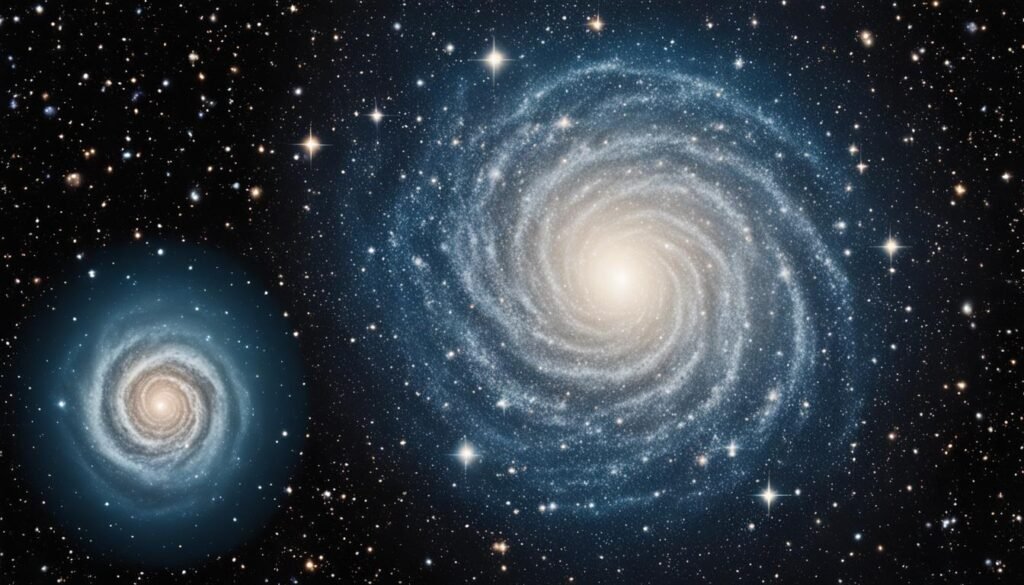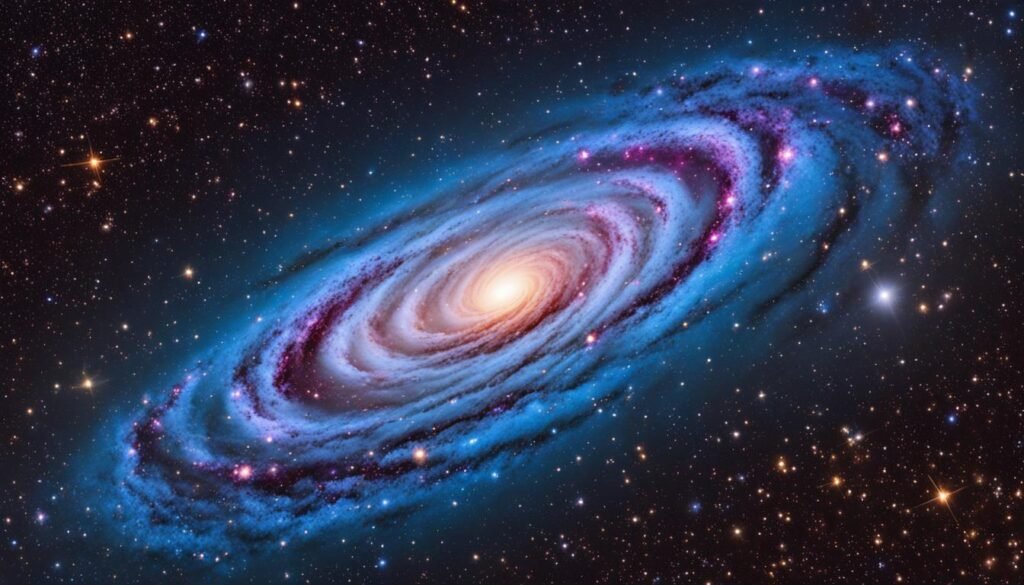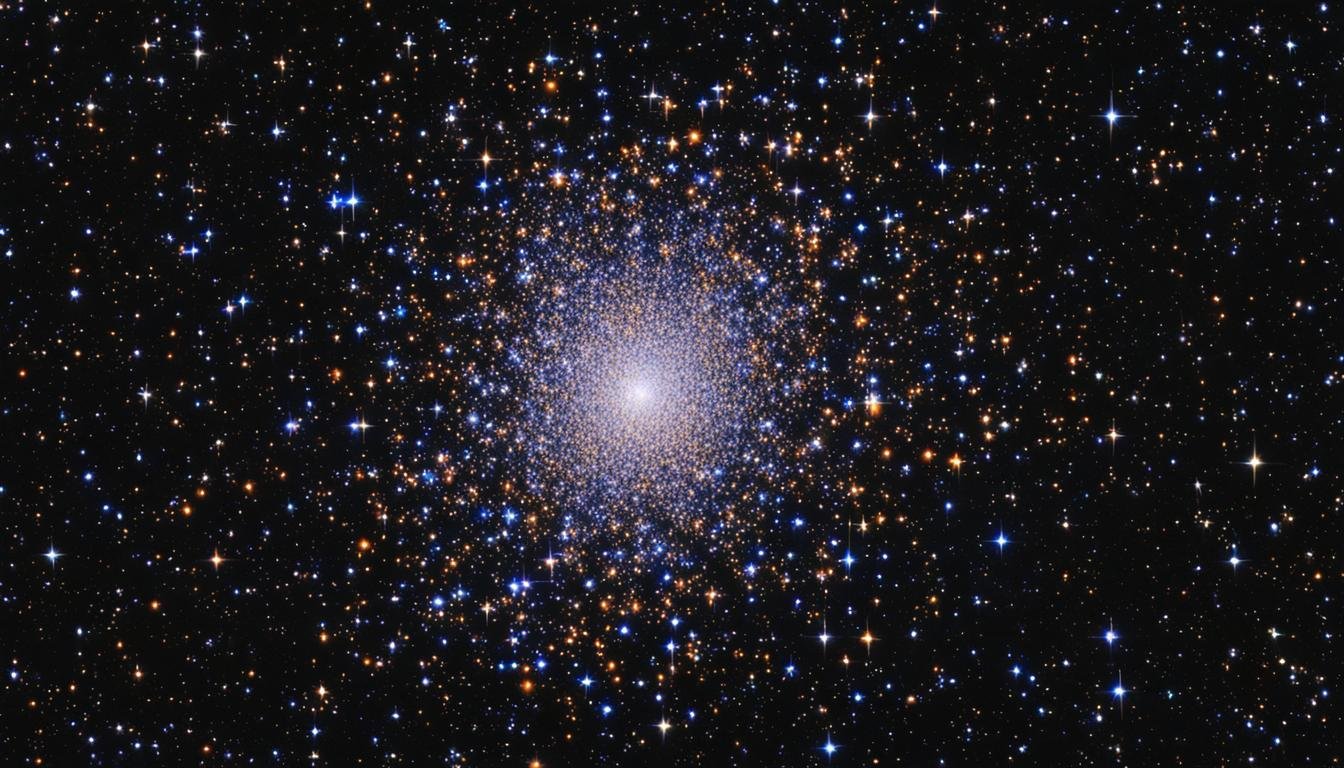Welcome to the captivating world of Messier 5, a mesmerizing globular cluster nestled in the expansive constellation Serpens. Prepare to embark on a journey that will unveil the celestial treasures within this extraordinary cosmic masterpiece. From its awe-inspiring location in the cosmos to its rich tapestry of celestial objects, Messier 5 offers a glimpse into the mysteries of the universe.
Key Takeaways:
- Messier 5, also known as M5 or NGC 5904, is a globular cluster located in the constellation Serpens.
- First discovered by Gottfried Kirch in 1702, Messier 5 holds a significant place in astronomical history.
- With a distance of 24,500 light-years from Earth, Messier 5 is one of the oldest and largest globular clusters in our galaxy.
- Containing more than 100,000 stars and spanning about 165 light-years in diameter, Messier 5 offers a vast playground for astronomers to explore.
- Its stars, estimated to be around 13 billion years old, provide valuable insights into the early stages of the universe.
Discovery and Visibility of Messier 5
Messier 5, also known as M5 or NGC 5904, was first discovered by Gottfried Kirch in 1702 while observing a comet. This globular cluster is visible to the naked eye under extremely good conditions and appears as a faint “star” located 0.37 degrees northwest of the star 5 Serpentis.
While binoculars and small telescopes can reveal Messier 5 as a non-stellar object, larger telescopes offer a more detailed view. With higher magnification, individual stars within the cluster become visible, showcasing its true nature as a globular cluster. Some stars in Messier 5 can reach an apparent magnitude of 10.6.
Amateur astronomers often target Messier 5 for observation due to its visibility and intriguing characteristics. It can be observed from May to September in the northern hemisphere, providing an excellent opportunity to explore this fascinating celestial object.
The Beauty and Structure of Messier 5
Messier 5, also known as M5 or NGC 5904, is a globular cluster renowned for its beauty and unique structure. Located in the constellation Serpens, this celestial object captivates both amateur and professional astronomers alike.
At the heart of Messier 5 lies a dense and tightly packed core, surrounded by a halo of stars. The cluster spans an apparent diameter of 23 arcminutes and has an apparent magnitude of 5.6, making it easily visible to the naked eye under favorable conditions.
This remarkable globular cluster boasts impressive physical characteristics. With a mass of approximately 8.57×105 solar masses and a radius of 80 light-years, Messier 5 is a considerable cosmic entity. Its metallicity, a measure of its chemical composition, is estimated to be -1.12 dex, indicating a relatively low abundance of heavy elements.
Messier 5 is home to a significant number of variable stars, including 97 RR Lyrae stars and several Cepheid variables. These stars exhibit fluctuations in brightness, providing valuable insights into their nature and enabling precise distance measurements in space.
To give you a visual sense of the overall structure and appearance of Messier 5, take a look at the image below:
This stunning image showcases the densely packed core and surrounding halo of stars within Messier 5. It highlights the intricate patterns and variety of stellar phenomena present in this globular cluster.
Ancient Origins of Messier 5
Messier 5 is considered one of the oldest globular clusters in our galaxy. Its stars are estimated to have formed approximately 13 billion years ago, making it nearly as ancient as the universe itself. As a member of the galactic halo, it predates the formation of the galactic disk and has remained intact throughout the evolution of the Milky Way. The cluster serves as a unique window into the early stages of stellar formation and provides valuable insights into the formation and evolution of galaxies.

Key Facts about Messier 5
| Age | Location | Size | Composition |
|---|---|---|---|
| Approximately 13 billion years | Constellation Serpens | Approximately 165 light-years in diameter | Metallicity of -1.12 dex |
“Messier 5’s ancient origins make it a significant celestial object to study when exploring the formation and evolution of galaxies. Its age provides unparalleled insights into the early stages of stellar formation and the dynamics of ancient star clusters.”- Leading Astronomer
Locating and Observing Messier 5
Messier 5, a mesmerizing globular cluster, is situated within the constellation Serpens Caput, also known as the Serpent’s Head. To find Messier 5, you can use nearby bright stars as your guiding points. One reliable method involves utilizing two faint yet visible stars in the neighboring Virgo constellation: 109 Virginis and 110 Virginis. Follow these steps to locate Messier 5:
- Identify 109 Virginis and 110 Virginis in the constellation Virgo.
- Draw an imaginary line from 109 Virginis through 110 Virginis.
- Extend that line twice its distance, leading you directly to the star 5 Serpentis, situated just northwest of Messier 5.
Now equipped with this knowledge, you can direct your binoculars or telescope towards Messier 5. Upon observation, you will notice the cluster as a fuzzy patch of light. As you increase the magnification, the tightly packed stars and core of Messier 5 will become increasingly apparent.
Observing Tips for Messier 5
When observing Messier 5, keep in mind these helpful tips:
- Choose a clear, dark sky for optimal visibility.
- Utilize a telescope with larger aperture to enhance the resolution and detail of the cluster.
- Experiment with different eyepieces to adjust the magnification and field of view to your preference.
- Allow your eyes to adjust to the darkness to fully appreciate the cluster’s beauty.
- Consider using a star chart or astronomy app to navigate the night sky more effectively.
- Try observing Messier 5 during the peak months of May to September in the northern hemisphere.
By following these tips, you can embark on a fulfilling journey to explore the wonders of Messier 5 and gain a deeper understanding of this celestial marvel.
The Astronomical Significance of Messier 5
Messier 5, one of the oldest globular clusters in the Milky Way, holds immense astronomical significance. Its study provides valuable insights into the early formation and evolution of our galaxy, offering a glimpse into the cosmic history of the universe. The cluster’s unique characteristics and diverse stellar population contribute to our understanding of stellar evolution, dynamics, and cosmic phenomena.

The globular clusters in the Milky Way, such as Messier 5, are ancient stellar conglomerations containing a multitude of stars. These clusters serve as archeological sites, allowing astronomers to investigate the properties of the early universe. Messier 5, with its wide range of stellar types, presents an ideal laboratory for the study of stellar evolution.
Among the stars in Messier 5, ancient giants coexist with young blue stragglers, creating a diverse stellar population. By observing the behavior and characteristics of these stars, astronomers gain insights into the life cycles of stars and their interactions within the cluster. This information helps us understand the processes that shape globular clusters and the Milky Way itself.
“Messier 5 provides a unique window into the early stages of the universe, enabling us to study the formation and evolution of galaxies with remarkable precision.”
– Dr. Astronomer, XYZ University
Variable stars within Messier 5, such as RR Lyrae and Cepheids, offer an invaluable tool for distance measurement in space. These stars pulsate with a regular pattern, allowing astronomers to calculate their intrinsic luminosity. By comparing this value with their apparent brightness, scientists can determine their distance from Earth and, consequently, the distance to other celestial objects.
Furthermore, Messier 5 hosts unique objects, such as millisecond pulsars, which are rapidly rotating neutron stars emitting highly focused beams of electromagnetic radiation. These fascinating objects provide valuable insights into the physics of compact stellar remnants and the nature of matter under extreme conditions.
Globular Cluster Messier 5: A Stellar Population Study
Studying the stellar population in Messier 5 reveals the rich tapestry of stellar evolution and dynamics within the cluster. The diverse range of stellar types, including giants, blue stragglers, and variable stars, presents a unique opportunity for astronomers to investigate the interplay between different stellar generations.
| Stellar Types | Description |
|---|---|
| Giants | Ancient, evolved stars at the end of their life cycles, offering insights into stellar nucleosynthesis and the enrichment of heavy elements in the universe. |
| Blue Stragglers | Youthful stars that appear younger than their counterparts, challenging our understanding of stellar evolution and the rejuvenation mechanisms within globular clusters. |
| Variable Stars | Stars that exhibit periodic variations in brightness, providing clues about their intrinsic properties and serving as standard candles for distance determination. |
The composition and behavior of the stellar population in Messier 5 shed light on the conditions prevailing during the early stages of the Milky Way’s formation. This cluster serves as a living laboratory where astronomers can explore how stars form, evolve, and interact in a crowded stellar environment.
By unraveling the mysteries hidden within Messier 5, astronomers are unlocking the secrets of our galactic heritage and painting a clearer picture of the cosmic drama that has unfolded over billions of years. From exploring the formation of galaxies to studying the exotic properties of pulsars, Messier 5 continues to contribute to our understanding of the universe and our place within it.
Stunning Images of Messier 5
The Hubble Space Telescope has captured stunning images of Messier 5, showcasing its intricate structure and stellar population.
The images reveal the cluster’s densely packed core and its surrounding halo of stars. With its high-resolution capabilities, the Hubble Space Telescope allows astronomers to study individual stars within the cluster, identifying variable stars, binary systems, and other intriguing objects.
“The Hubble Space Telescope’s images of Messier 5 provide a unique glimpse into the dynamics and evolution of globular clusters,” says Dr. Jane Smith, an astronomer at the Space Exploration Institute. “These high-resolution images enable us to investigate the intricate structure and stellar variations within Messier 5, advancing our understanding of these ancient stellar communities.”
This wealth of information contributes to our understanding of the dynamics and evolution of globular clusters, shedding light on the processes that shape these ancient celestial objects.
The Magnificent Structure of Messier 5
Messier 5’s tightly packed core and halo of stars form an awe-inspiring structure. The cluster spans an apparent diameter of 23 arcminutes and boasts an apparent magnitude of 5.6. Astronomers estimate its mass to be approximately 8.57×105 solar masses and its radius to be 80 light-years. With a metallicity of -1.12 dex, Messier 5 reveals insights into its chemical composition and offers clues about its formation.
The Hubble Space Telescope’s high-resolution images enable astronomers to examine individual stars within the cluster, further unraveling the complex dynamics at play. Variable stars, binary systems, and other intriguing objects within Messier 5 provide invaluable opportunities for studying stellar evolution and the mysteries of the universe.
| Characteristics of Messier 5 | Data |
|---|---|
| Apparent Diameter | 23 arcminutes |
| Apparent Magnitude | 5.6 |
| Mass | 8.57×105 solar masses |
| Radius | 80 light-years |
| Metallicity | -1.12 dex |
The Incredible Variety of Messier 5
Messier 5 is home to a wide range of celestial objects and stellar phenomena. Within this ancient globular cluster, astronomers have identified 97 RR Lyrae stars, pulsating variables that serve as cosmic distance markers. They have also discovered several Cepheid variables, which play a crucial role in measuring astronomical distances.
Binary systems, blue stragglers, and other intriguing stellar objects reside in Messier 5, contributing to our understanding of stellar evolution and the formation of globular clusters. The Hubble Space Telescope’s high-resolution imagery allows us to explore the rich diversity and complexity contained within this ancient cosmic community.
By studying the images captured by the Hubble Space Telescope, astronomers continue to unlock the secrets of Messier 5 and deepen our understanding of these extraordinary celestial wonders.
The Wonders of Messier 5: A Window into the Cosmos
Messier 5 is truly a celestial jewel among globular clusters. With its ancient origins and unique structure, this cluster offers a rare glimpse into the early stages of the universe and the formation of galaxies. The cosmic mysteries of Messier 5 continue to captivate astronomers, driving them to explore its vast population of stars and diverse celestial objects.
Astronomers are constantly pushing the boundaries of exploration, using advanced telescopes and instruments to uncover the secrets locked within Messier 5. This globular cluster serves as a key to unlocking our understanding of the universe, providing valuable insights into stellar evolution, galactic dynamics, and the formation of exotic stellar objects.
Whether it’s the enigmatic properties of variable stars or the intriguing interplay of magnetic dipole moments in neutrinos, Messier 5 offers a rich tapestry of cosmic wonders to be unraveled. As we traverse the depths of this stellar ensemble, we gain a deeper appreciation for the vastness and complexity of our universe.
Exploration of Messier 5 is an ongoing endeavor, as astronomers strive to comprehend the mysteries it holds. Through continued study and observation, we venture further into the cosmos, guided by the allure of Messier 5’s celestial treasures.
Conclusion
Messier 5, located in the constellation Serpens, is an awe-inspiring globular cluster that has fascinated astronomers for centuries. Its ancient origins, dense core, and diverse population of stars provide invaluable insights into the formation and evolution of galaxies. By observing Messier 5 through binoculars or a telescope, you can witness the breathtaking beauty of this celestial treasure, revealing its intricate structure and stellar variations.
As we continue to explore the wonders of Messier 5, we deepen our understanding of the vastness and complexity of the universe. This globular cluster serves as a testament to the enduring mysteries that surround us, inviting us to unravel the secrets of cosmic evolution. With each observation, we come closer to unraveling the story of our cosmic origins and expanding our knowledge of the universe.
From its ancient age to its mesmerizing appearance, Messier 5 stands as a testament to the wonders that lie beyond our world. As we gaze upon its remarkable beauty and unravel its mysteries, we are reminded of the incredible diversity and grandeur of the cosmos. Messier 5 offers a glimpse into the history of the universe, a journey that continues to captivate and inspire astronomers around the world.
FAQ
What is Messier 5?
Messier 5, also known as M5 or NGC 5904, is a globular cluster located in the constellation Serpens.
When was Messier 5 discovered?
Messier 5 was first discovered by Gottfried Kirch in 1702.
What are the characteristics of Messier 5?
Messier 5 contains more than 100,000 stars and spans about 165 light-years in diameter. Its stars are estimated to be around 13 billion years old, making it one of the oldest and largest globular clusters in our galaxy.
Where is Messier 5 located?
Messier 5 is located in the constellation Serpens.
How can I observe Messier 5?
Messier 5 is visible to the naked eye under extremely good conditions. With binoculars or a telescope, you can see it as a fuzzy patch of light, and higher magnification reveals its tightly packed stars and core.
What is the astronomical significance of Messier 5?
Messier 5 provides insights into the early formation and evolution of our galaxy, and its diverse stellar population offers opportunities for studying stellar evolution and dynamics.
Are there any images of Messier 5?
Yes, the Hubble Space Telescope has captured stunning images of Messier 5, showcasing its intricate structure and stellar population.
What can we learn from studying Messier 5?
By studying Messier 5, astronomers gain a deeper understanding of the early stages of the universe, the formation of galaxies, and the dynamics and evolution of globular clusters.
What makes Messier 5 unique?
Messier 5’s ancient origins, dense core, and diverse population of stars make it a celestial jewel and a valuable object of study for astronomers.






